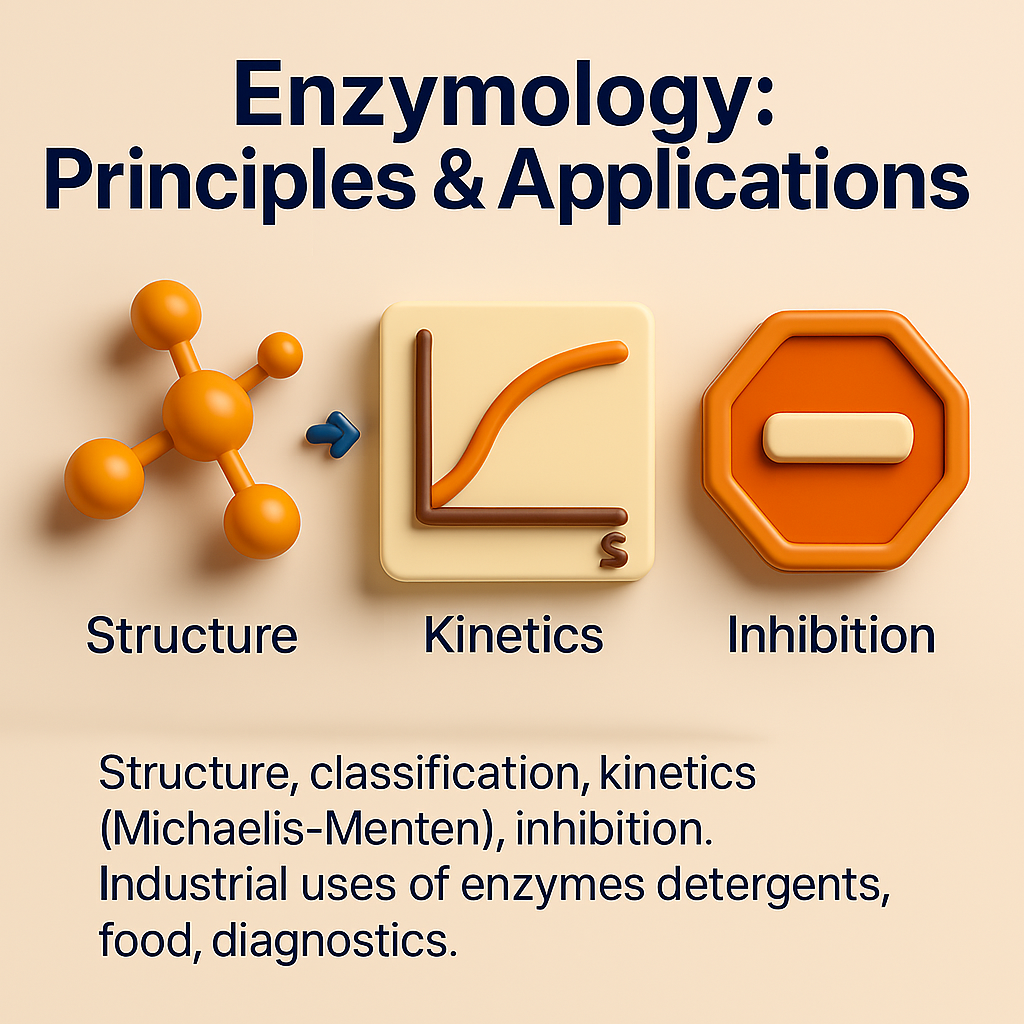
🧬 Enzymology: Principles & Applications
🔍 What are enzymes?
Enzymes are biological catalysts — special proteins (or sometimes RNA molecules) that speed up chemical reactions in living organisms.
Without enzymes, most reactions in our bodies and in nature would be too slow to sustain life.
Think of them as tiny molecular machines that help break things down or build things up, precisely and efficiently.
🧩 How do enzymes work?
Enzymes work by lowering the activation energy needed for a reaction to occur.
This means the reactants (called substrates) can be converted into products much faster.
Each enzyme has a unique 3D shape with an active site — a special pocket where the substrate fits, like a key fitting into a lock.
⚙️ The basic mechanism:
Enzyme binds to substrate:
Forming an enzyme-substrate complex.Catalysis occurs:
The enzyme changes the substrate into product(s).Product is released:
The enzyme is free to work again — it’s not consumed in the reaction.
📊 Understanding enzyme kinetics
Michaelis-Menten Model
This is the most common model to describe enzyme activity.
Vmax: The maximum rate of the reaction when the enzyme is saturated with substrate.
Km: The substrate concentration at which the reaction rate is half of Vmax.
It tells us about the enzyme’s affinity for the substrate (lower Km = higher affinity).
Visualizing this often involves the classic hyperbolic curve (Michaelis-Menten plot).
⛔ Enzyme inhibition
Enzymes can be slowed down or blocked by inhibitors.
Competitive inhibitors:
Bind to the active site, competing with the substrate.Non-competitive inhibitors:
Bind elsewhere on the enzyme, changing its shape so it works less effectively.
This concept is important in drug design — many antibiotics and cancer drugs are enzyme inhibitors.
🌏 Applications of enzymes in biotechnology & industry
Enzymes are not just fascinating biologically — they have huge industrial applications:
🧴 Detergents:
Enzymes like proteases & lipases break down protein & fat stains in clothes.
🍞 Food & beverages:
Amylases break down starch in bread-making.
Brewers use enzymes to convert grains into fermentable sugars.
🧬 Molecular biology:
Restriction enzymes cut DNA at specific sites.
DNA polymerases are used in PCR to amplify DNA.
💉 Healthcare & diagnostics:
Enzymes power glucose test strips for diabetics.
ELISA kits rely on enzyme-linked reactions to detect diseases.
♻️ Environmental biotech:
Enzymes help in waste treatment, breaking down pollutants.
🌱 Why should students learn enzymology?
It builds the foundation for understanding metabolism, molecular biology, genetic engineering, and industrial biotech.
Essential for interpreting lab experiments, enzyme assays, and studying diseases caused by enzyme deficiencies.
Critical in bioinformatics too, where protein structure & function prediction often revolves around enzymes.
✅ In short:
Enzymology sits at the very heart of biotechnology.
By understanding how enzymes work, how to measure their activity, and how they’re used, you’re opening the door to innovations in health, food, environment, and beyond.
✅ Summary Table: Key Enzymes, Substrates & Industrial Uses
| Enzyme | Substrate | Product(s) | Typical Industrial / Biotech Use |
|---|---|---|---|
| Amylase | Starch (polysaccharides) | Maltose, glucose (simple sugars) | Baking (bread softness), brewing (beer), starch processing |
| Protease | Proteins | Peptides, amino acids | Detergents (break down stains), leather industry, food tenderizers |
| Lipase | Fats (triglycerides) | Glycerol & fatty acids | Detergents, dairy (flavor enhancement), biodiesel production |
| Cellulase | Cellulose (plant fibers) | Glucose | Textile (softening fabrics), paper (biobleaching), bioethanol from biomass |
| Lactase | Lactose (milk sugar) | Glucose & galactose | Making lactose-free milk & dairy products |
| Invertase | Sucrose (table sugar) | Glucose & fructose | Confectionery & soft drinks (invert sugar syrup) |
| Pectinase | Pectin (fruit cell walls) | Simpler carbohydrates | Juice clarification, wine production |
| Glucose oxidase | Glucose | Gluconic acid + H2O2 | Glucose test strips (diabetes), food preservation |
| DNA polymerase | DNA template + nucleotides | New DNA strands | PCR (DNA amplification) in molecular biology |
| Restriction enzymes (e.g. EcoRI) | DNA at specific sites | DNA fragments | Genetic engineering, cloning |
